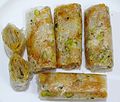| Name | Image | Main ingredients | Category |
|---|
| Amriti |  | Deep fried vigna mungo , sugar syrup. | Fried, sugar syrup based |
| Chak-Hao Kheer |  | Black rice, milk , sugar | milk based |
|
| Cham cham |  | Flour, cream, sugar, saffron, lemon juice, coconut flakes. | Milk-based |
| Chandrapuli |  | Khoa, sugar, ghee, coconut flakes. | Coconut and milk based |
| Chhena gaja |  | Chhena, sugar, ghee. | Milk-based |
| Chhena jalebi |  | Chhena, sugar, ghee. | Milk-based |
| Chhena Jhili |  | whole milk, refined flour, powdered sugar, cardamom, oil/ghee for deep frying | Milk based |
| Chhena kheeri |  | Chhena, sugar, milk. | Milk-based |
| Chhena poda |  | Sugar, chenna cheese. | Milk-based |
| Chuda Ghasa |  | Rice Flakes (Poha), Sugar powder or Jaggery, Desi Ghee, Grated fresh Coconut, Pepper Powder, big cardamon powder, Dry fruits Optional | Flatten rice/rice flakes, sugar/jaggery, ghee based |
| Coconut Barfi |  | Made from coconut, fine ground sugar, ghee, cardamom powder and milk. | Coconut and milk based |
| Jaynagarer Moa |  | gur, cow ghee, Kanakchur khoi | Fried and Rice-based |
| Kheer sagar |  | Chenna, condensed milk, sugar, saffron, cardamom. | Milk-based |
| Kolar Bora |  | banana, coconut, maida, sugar, oil | Fried and Banana-based |
| Labanga latika |  | maida, khoa, nutmeg (powdered), grated coconut, ghee, nuts, raisins, cardamom, cloves and sugar | Fried and sugar-syrup based |
| Ledikeni | | Chhena, sugar, ghee. | Milk-based |
| Lyangcha |  | Flour, fried milk powder, sugar syrup. | Milk-based |
| Malapua (dessert) |  | Yogurt, refined flour, ghee, fennel seeds. | Milk-based |
| Mihidana |  | Besan flour, sugar, ghee. | Fried, sugar syrup based |
| Misti doi |  | Yogurt, jaggery. | Milk-based |
| Pantua |  | Chhena, sugar, ghee | Milk-based |
| Pitha |  | Rice flour. | Milk-based |
| Puri Khaja |  | Refined flour (maida), pure ghee, sugar, refined cooking oil for frying (Pure ghee may also be used for frying) Salt to taste | Ghee and refined flour-based |
| Rabri |  | Sweetened milk. | Milk-based |
| Rasabali |  | Chenna, sweetened milk. | Milk-based |
| Ras malai |  | Chhena, reduced milk, pistachio | Milk-based |
| Rasgulla |  | Chhena, sugar | Milk-based |
| Sandesh |  | Made from cheese, kneaded with fine ground sugar and molasses. [11] | Milk-based |
| Sarpuria |  | cream, sugar, maida, ghee cardamom powder | Fried and Milk-based |
| Sirir naru |  | jaggery and gram flour, mustard oil for deep fry | Jaggery based |
| Shorbhaja |  | sugar, cream, ghee, maida | Fried, milk and sugar syrup-based |
| Sitabhog |  | Chhena, rice flour, sugar, vermicelli/rice | Fried, rice, and sugar-syrup based |

























































![attprthm[?].JPG](http://upload.wikimedia.org/wikipedia/commons/thumb/e/e3/%E0%B4%85%E0%B4%9F%E0%B4%AA%E0%B5%8D%E0%B4%B0%E0%B4%A5%E0%B4%AE%E0%B5%BB.JPG/120px-%E0%B4%85%E0%B4%9F%E0%B4%AA%E0%B5%8D%E0%B4%B0%E0%B4%A5%E0%B4%AE%E0%B5%BB.JPG)





































